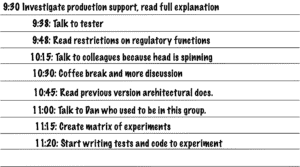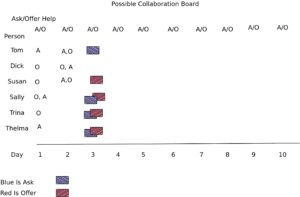For years, managers have been trying to find ways to make software product development faster and easier. As an industry, we've tried tons of things. Here are just the one I've experienced in the 70s, 80s, 90s:
- Structured Analysis and Design. (That was the precursor to Big Design Up Front.)
- The SEI's Capability Maturity Model
- The waterfall lifecycle (In Project Lifecycles, I said this might have been a pagination error.)
I never had to experience CASE tools in the 90s.
Now, we have at least these:
- Low code environments so people can write their own code. I think of spreadsheets as an unintentional, but prime example of this.
- “Agile” as a way to do much more work in much less time. (NO! It doesn't work that way!!)
- AI to take the place of humans in product development.
I'm a huge fan of tools that help me do my job. And I don't want to return to the bad old days—I much prefer where we are now.
But, as an industry, we continue to look for the recipe, the shortcut, the silver bullet, all to decrease the time and cost of product development. (I won't address our need for personal silver bullets in this post, but they certainly exist, too.)
There is one silver bullet for product development—the speed of team learning time.
The Real Silver Bullet: Team Learning Time
 When I work with leaders and teams, I explain that when the team learns together faster, the team can reduce their product development time. That's because they don't have unplanned feedback loops as in the image on the left.
When I work with leaders and teams, I explain that when the team learns together faster, the team can reduce their product development time. That's because they don't have unplanned feedback loops as in the image on the left.
And the more a team collaborates (see Measure Cycle Time, Not Velocity), the faster the team can proceed. That means integrating code review and testing as part of the team's collaboration. (Read See and Resolve Team Dependencies, Part 1: Inside the Team for a value stream map where the team separates code review from their flow of work.)
Team learning time requires that the team—not just the managers—think in flow efficiency.
That changes the questions teams often ask themselves. Instead of asking, “How can we take utilize each person's capabilities for this story?” the question becomes:
“How can we grow everyone's capabilities so we learn faster, now and in the future?”
I care about the future because most of product development time is learning what happened before, not typing. The faster we can learn, the faster we can release the product.
What People Do in Product Development
 If you are a part of a product development team and you work alone, consider this experiment. Take a legal pad, or some other large-enough piece of paper. (Yes, use paper, because you will interrupt yourself less than if you use an electronic tool.)
If you are a part of a product development team and you work alone, consider this experiment. Take a legal pad, or some other large-enough piece of paper. (Yes, use paper, because you will interrupt yourself less than if you use an electronic tool.)
When you start a new task, write down the time you start that work and what you do. Are you reading, searching, asking AI, something else?
Now, every time you either change mode (reading code, asking AI, talking with others) or change task (the type of work), write that down on your paper.
This image has an anonymized example of what occurred with a developer. He read alone (a total of 50 minutes). When he was stuck, he spoke with people. That's because his team had a working agreement to include asking for and offering help.
 His team used this collaboration board (from Create Your Successful Agile Project), where they tracked asking for and offering help.
His team used this collaboration board (from Create Your Successful Agile Project), where they tracked asking for and offering help.
However, I don't often see teams that purposefully track when the offer and ask for help. Asking for help is just the first step. The real issue is that when people offer help, they increase the team's collaboration and learning.
That learning helps to reduce the team's feedback loops, and it speeds the product development. Learning also increases everyone's capabilities for the future.
All of us learn, often through reading. We type much less often than we read. And that challenges everyone's desire for the shortcut.
Tools might help us.
Silver Bullets Don't Exist But Tools Might Help
We have at least two tools that can support faster learning: agile approaches and AI. Agile approaches work, especially if you focus on reducing cycle time. In general, teams need to collaborate to reduce their cycle time. (See Project Lifecycles for more information.) Increase collaboration often leads to faster learning.
At this point—and I'm sure things will change soon-ish—AI can summarize previously written material. It might even write code that can help you. If you pay for your AI, you might even be able to control its hallucinations.
But I don't see AI creating new and innovative products yet. I'm not ruling that out, but I don't see it yet. (So far, all the AI-generated articles I've read are boring, boring.)
I'm so happy I live in an age where improved technology—my tools—has made it possible for me to do things I could never even imagine back when I started to work. But those tools are not silver bullets.
If you see your management looking for a silver bullet to reduce the time and cost of product development, remind them we have at least one major tool to do so: agility and team collaboration on just one product at a time. Agility not only increases team autonomy, mastery, and purpose, but it focuses on fast learning and fast customer feedback.
We don't need to search for silver bullets—we already have them. Now, it's time to use them and reduce the time and cost of product development. A cultural challenge, for sure. But one that deserves our time and attention to get right.
Great post, Johanna.
Seems to me like true collaboration will never go out of style!
Thanks, Toyin!